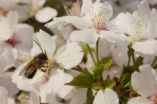(Press-News.org) Claudia Bieber from the Research Institute of Wildlife Ecology (FIWI) of the University of Veterinary Medicine, Vienna, and fellow scientists analysed a capture-recapture data set on common dormice (Muscardinus avellanarius) to investigate the life-history strategy of this species. These small rodents are about the size and weight of a wood mouse (Apodemus sylvaticus), but, unlike their rodent cousins, they hibernate – usually from late September/October to April/May. This is reflected in rather different life history strategies: While wood mice may reproduce any time between February and October and have multiple litters in one season, common dormice give birth to young either as early as possible after waking up from hibernation, or as late as possible, just in time to get the young fit for hibernation. The research findings are published in the current issue of the international journal Oecologia.
According to life-history theory, a species´ reproductive strategy (e.g. time of sexual maturity, first reproduction, litter size, and other factors) is evolutionarily adapted to the environmental constraints encountered by that species in its natural habitat, such as availability of food resources and predictability of the environment. The aim generally is to produce the largest possible number of surviving offspring under particular conditions.
The researchers observed in a wild dormouse population in Lithuania two peaks of reproduction within the active season. About one third of the litters were born early in the year (June), but the majority were born late in the active season (August/September). In mid-summer, however, only a small fraction of females gave birth to litters, although environmental conditions did not impair investment into reproduction in this time frame. While wood mice, for example, have what is generally known as a "fast" life history, common dormice apparently have some flexibility to adjust their life history tactics (early versus delayed reproduction) to circumstances. Dr. Claudia Bieber and her fellow scientists hypothesized that the ability to hibernate may explain this unusual bimodal birth pattern in the hazel dormouse.
So far relatively little is known about hibernation and survival rates of small hibernators, such as common dormice. By means of a long-term mark and re-capture study, the researchers were able to determine that, unlike previously thought, survival rates were high during the hibernation period for all age-groups. Thus, even animals born late in the active season face a period with high survival probability during the upcoming winter season.
By comparing lifetime reproductive success (the number of juveniles produced in a females' lifetime) the scientists found that the early-born juveniles outpace their late-born counterparts. The May-born cohort often manages to raise their first litter in the same year. In populations under high predation pressure, like the one in Lithuania, this "fast" life history strategy seems to convey an advantage. However, only females that already have a high body-mass in the spring manage to invest into early reproduction – for females with lower body-mass it is better to delay reproduction until late in the active season, which maximises the chances of survival of their young. This is referred to as a "slow" life history strategy. "Most interesting is the fact that we observed "fast" and "slow" life histories occurring within the same population," says Claudia Bieber, lead author of the study. "It turns out that life histories are much more flexible within a species and even within a population than so far expected."
###
The article "High survival during hibernation affects onset and timing of reproduction" by Claudia Bieber, Rimvydas Junkaitis, Christopher Turbill and Thomas Ruf is published in the current issue of the journal "Oecologia" (Volume 169, Number 1 (2012), 155-166, DOI: 10.1007/s00442-011-2194-7).
Abstract of the scientific article online (full text for a fee or with a subscription):
http://www.springerlink.com/content/n2757084356m77p4/
Contact
Dr. Claudia Bieber
Research Institute of Wildlife Ecology
University of Veterinary Medicine, Vienna
T +43 1 489 0915-230
E claudia.bieber@vetmeduni.ac.at
www.vetmeduni.ac.at/fiwi
Released by
Klaus Wassermann
Public Relations/Science Communication
University of Veterinary Medicine, Vienna
T +43 1 25077-1153
E klaus.wassermann@vetmeduni.ac.at
When to have kids: A complex question for hazel dormice
2012-04-30
ELSE PRESS RELEASES FROM THIS DATE:
Polluting China for the sake of economic growth
2012-04-30
China's economic growth will continue to be energy-intensive and highly polluting for the foreseeable future with emissions and efficiency far below capital growth on the agenda, according to a study published in the International Journal of Global Energy Issues.
Economist Yanqing Xia of Dongbei University of Finance and Economics and the Northeast Branch of the Chinese Academy of Sciences in Liaoning has looked at almost a decade's worth of data from 30 Chinese provinces to build a comprehensive model of pollution, energy consumption and economic growth. The model offers ...
Doubling the information from the double helix
2012-04-30
Our genes control many aspects of who we are — from the colour of our hair to our vulnerability to certain diseases — but how are the genes, and consequently the proteins they make themselves controlled?
Researchers have discovered a new group of molecules which control some of the fundamental processes behind memory function and may hold the key to developing new therapies for treating neurodegenerative diseases.
The research, led by academics from the University of Bristol's Schools of Clinical Sciences, Biochemistry and Physiology and Pharmacology and published ...
Deadly decision: Obese drivers are far less likely to buckle up
2012-04-30
BUFFALO, N.Y. -- Obese drivers are far less likely to wear seatbelts than are drivers of normal weight, a new University at Buffalo study has found, a behavior that puts them at greater risk of severe injury or death during motor vehicle crashes.
The UB study found that normal weight drivers are 67 percent more likely to wear a seatbelt than morbidly obese drivers. Drivers were considered overweight or obese if they had a BMI (body mass index) of 25 or more, according to the World Health Organization definition of obesity, with 25-30 defined as overweight, 30-35 slightly ...
Fruit flies provide new knowledge about uninhibited cell growth
2012-04-30
In a new study, scientists at the University of Copenhagen show that a specific type of carbohydrate plays an important role in the intercellular signalling that controls the growth and development of the nervous system. In particular, defects in that carbohydrate may result in the uninhibited cell growth that characterizes the genetic disease neurofibromatosis and certain types of cancer. The results have just been published in the well-reputed journal PNAS.
Scientists from The Faculty of Health and Medical Sciences at the University of Copenhagen have put a special ...
Researchers from the University of Zurich discover new particle at CERN
2012-04-30
This press release is available in German.
In particle physics, the baryon family refers to particles that are made up of three quarks. Quarks form a group of six particles that differ in their masses and charges. The two lightest quarks, the so-called "up" and "down" quarks, form the two atomic components, protons and neutrons. All baryons that are composed of the three lightest quarks ("up", "down" and "strange" quarks) are known. Only very few baryons with heavy quarks have been observed to date. They can only be generated artificially in particle accelerators as ...
Atomic clock comparison via data highways
2012-04-30
This press release is available in German.
Optical atomic clocks measure time with unprecedented accuracy. However, it is the ability to compare clocks with one another that makes them applicable for high-precision tests in fundamental theory, from cosmology all the way to quantum physics. A clock comparison, i.e. a comparison of their optical frequencies, proved to be challenging so far as the few existing optical clocks around the world are not readily portable due to their complex nature. A team of researchers from the Physikalisch-TechnischeBundesanstalt (PTB) in ...
Global prices of pollination-dependent products such as coffee could rise in the long term
2012-04-30
This press release is available in German.
Leipzig/Dresden/Freiburg. In recent years the economic value of pollination-dependent crops has substantially increased around the world. As a team of researchers from the Helmholtz Centre for Environmental Research (UFZ), the Technical University of Dresden and the University of Freiburg headed by the UFZ wrote in an article entitled "Spatial and temporal trends of global pollination benefit" in the open-access journal PLoS ONE the value of ecological pollination services was around 200 billion US dollars in 1993 and rose ...
New drug to tackle fat problems
2012-04-30
Medical researchers at the University of Sheffield have defined the structure of a key part of the human obesity receptor- an essential factor in the regulation of body fat- which could help provide new treatments for the complications of obesity and anorexia.
This major advance in research, published in the journal Structure, will greatly enhance the ability to generate drugs which can both block and stimulate the receptor for the obesity hormone leptin. This could have life-changing effects on people suffering from the complications of obesity and malnutrition.
Researchers ...
Blood samples show deadly frog fungus at work in the wild
2012-04-30
The fungal infection that killed a record number of amphibians worldwide leads to deadly dehydration in frogs in the wild, according to results of a new study.
High levels of an aquatic, chytrid fungus called Batrachochytrium dendrobatidis (Bd) disrupt fluid and electrolyte balance in wild frogs, the scientists say, severely depleting the frogs' sodium and potassium levels and causing cardiac arrest and death.
Their findings confirm what researchers have seen in carefully controlled lab experiments with the fungus, but San Francisco State University biologist Vance ...
Can nature's beauty lift citizens from poverty?
2012-04-30
Using nature's beauty as a tourist draw can boost conservation in China's valued panda preserves, but it isn't an automatic ticket out of poverty for the humans who live there, a unique long-term study shows.
Often those who benefit most from nature-based tourism are people who already have resources. The truly impoverished have a harder time breaking into the tourism business, according to the paper, "Drivers and Socioeconomic Impacts of Tourism Participation in Protected Areas," published in the April 25 edition of PLoS One.
The study looks at nearly a decade of burgeoning ...



